Advanced Character Physics
Página 4 de 16
be demonstrated how the above integration scheme leads to increased stability and a
decreased amount of computation when compared to other approaches.
Try setting a=(0,0,1), for example, and use the start condition x=(1,0,0), x*=(0,0,0), then do
a couple of iterations by hand and see what happens.
3 Collision and contact handling by projection
So-called penalty-based schemes handle contact by inserting springs at the penetration
points. While this is very simple to implement, it has a number of serious drawbacks. For
instance, it is hard to choose suitable spring constants such that, on one hand, objects
don’t penetrate too much and, on the other hand, the resulting system doesn’t get unstable.
In other schemes for simulating physics, collisions are handled by rewinding time (by binary
search for instance) to the exact point of collision, handling the collision analytically from
there and then restarting the simulation – this is not very practical from a real-time point of
view since the code could potentially run very slowly when there are a lot of collisions.
Here, we use yet another strategy. Offending points are simply projected out of the
obstacle. By projection, loosely speaking, we mean moving the point as little as possible
until it is free of the obstacle. Normally, this means moving the point perpendicularly out
towards the collision surface.
Let’s examine an example. Assume that our world is the inside of the cube (0,0,0)-
(1000,1000,1000) and assume also that the particles’ restitution coefficient is zero (that is,
particles do not bounce off surfaces when colliding). To keep all positions inside the valid
interval, the corresponding projection code would be:
// Implements particles in a box
void ParticleSystem::SatisfyConstraints() {
for(int i=0; i
Advanced Character Physics
Página 5 de 16
Strong springs leads to stiff systems of equations that lead to instability if only simple
integration techniques are used, or at least bad performance – which leads to pain.
Conversely, weak springs lead to elastically looking cloth.
However, an interesting thing happens if we let the stiffness of the springs go to infinity: The
system suddenly becomes solvable in a stable way with a very simple and fast approach.
But before we continue talking about cloth, let’s revisit the previous example. The cube
considered above can be thought of as a collection of unilateral (inequality) constraints (one
for each side of the cube) on the particle positions that should be satisfied at all times:
≥
x
i
and 0
x
i
≤
i
for
1000
=
.3,2,1
(C1)
In the example, constraints were satisfied (that is, particles are kept inside the cube) by
simply modifying offending positions by projecting the particles onto the cube surface. To
satisfy (C1), we use the following pseudo-code
// Pseudo-code to satisfy (C1)
for i=1,2,3
set xi=min{max{xi, 0}, 1000}
One may think of this process as inserting infinitely stiff springs between the particle and
the penetration surface – springs that are exactly so strong and suitably damped that
instantly they will attain their rest length zero.
We now extend the experiment to model a stick of length 100. We do this by setting up two
individual particles (with positions x1 and x2) and then require them to be a distance of 100
apart. Expressed mathematically, we get the following bilateral (equality) constraint:
|
x2
− x1
.
(C2)
=
|
100
Although the particles might be correctly placed initially, after one integration step the
separation distance between them might have become invalid. In order to obtain the correct
distance once again, we move the particles by projecting them onto the set of solutions
described by (C2). This is done by pushing the particles directly away from each other or by
pulling them closer together (depending on whether the erroneous distance is too small or
too large). See Figure 2.
Dist. too large
Correct distance
Dist. too small
Figure 2. Fixing an invalid distance by moving the particles.
The pseudo-code for satisfying the constraint (C2) is
file://C:\Documents%20and%20Settings\toni\Escritorio\Advanced%20Character%20...
24/02/2003
�
Advanced Character Physics
Página 6 de 16
// Pseudo-code to satisfy (C2)
delta = x2-x1;
deltalength = sqrt(delta*delta);
diff = (deltalength-restlength)/deltalength;
x1 += delta*0.5*diff;
x2 -= delta*0.5*diff;
Note that delta is a vector so delta*delta is actually a dot product. With restlength=100 the
above pseudo-code will push apart or pull together the particles such that they once more
attain the correct distance of 100 between them. Again we may think of the situation as if a
very stiff spring with rest length 100 has been inserted between the particles such that they
are instantly placed correctly.
Now assume that we still want the particles to satisfy the cube constraints. By satisfying the
stick constraint, however, we may have invalidated one or more of the cube constraints by
pushing a particle out of the cube. This situation can be remedied by immediately projecting
the offending particle position back onto the cube surface once more – but then we end up
invalidating the stick constraint again.
Really, what we should do is solve for all constraints at once, both (C1) and (C2). This
would be a matter of solving a system of equations. However, we choose to proceed
indirectly by local iteration. We simply repeat the two pieces of pseudo-code a number of
times after each other in the hope that the result is useful. This yields the following code:
// Implements simulation of a stick in a box
void ParticleSystem::SatisfyConstraints() {
for(int j=0; j
Advanced Character Physics
Página 7 de 16
This means that stopping early will not ruin everything although the resulting animation
might appear somewhat sloppier.
Cloth simulation
The fact that a stick constraint can be thought of as a really hard spring should make
apparent its usefulness for cloth simulation as sketched in the beginning of this section.
Assume, for example, that a hexagonal mesh of triangles describing the cloth has been
constructed. For each vertex a particle is initialized and for each edge a stick constraint
between the two corresponding particles is initialized (with the constraint’s “rest length”
simply being the initial distance between the two vertices).
The function HandleConstraints() then uses relaxation over all constraints. The relaxation
loop could be iterated several times. However, to obtain nicely looking animation, actually
for most pieces of cloth only one iteration is necessary! This means that the time usage in
the cloth simulation depends mostly on the N square root operations and the N divisions
performed (where N denotes the number of edges in the cloth mesh). As we shall see, a
clever trick makes it possible to reduce this to N divisions per frame update – this is really
fast and one might argue that it probably can’t get much faster.
// Implements cloth simulation
struct Constraint {
int particleA, particleB;
float restlength;
};
// Assume that an array of constraints, m_constraints, exists
void ParticleSystem::SatisfyConstraints() {
for(int j=0; j
Advanced Character Physics
Página 8 de 16
Notice that if the distance is already correct (that is, if |delta|=restlength), then one gets
delta=(0,0,0) and no change is going to happen.
Per constraint we now use zero square roots, one division only, and the squared value
restlength*restlength can even be precalculated! The usage of time consuming operations
is now down to N divisions per frame (and the corresponding memory accesses) – it can’t
be done much faster than that and the result even looks quite nice. Actually, in Hitman, the
overall speed of the cloth simulation was limited mostly by how many triangles it was
possible to push through the rendering system.
The constraints are not guaranteed to be satisfied after one iteration only, but because of
the Verlet integration scheme, the system will quickly converge to the correct state over
some frames. In fact, using only one iteration and approximating the square root removes
the stiffness that appears otherwise when the sticks are perfectly stiff.
By placing support sticks between strategically chosen couples of vertices sharing a
neighbor, the cloth algorithm can be extended to simulate plants. Again, in Hitman only one
pass through the relaxation loop was enough (in fact, the low number gave the plants
exactly the right amount of bending behavior).
The code and the equations covered in this section assume that all particles have identical
mass. Of course, it is possible to model particles with different masses, the equations only
get a little more complex.
To satisfy (C2) while respecting particle masses, use the following code:
// Pseudo-code to satisfy (C2)
delta = x2-x1;
deltalength = sqrt(delta*delta);
diff = (deltalength-restlength)
x1 += invmass1*delta*diff;
x2 -= invmass2*delta*diff;
Here invmass1 and invmass2 are the numerical inverses of the two masses. If we want a
particle to be immovable, simply set invmass=0 for that particle (corresponding to an infinite
mass). Of course in the above case, the square root can also be approximated for a speed-
up.
5 Rigid bodies
The equations governing motion of rigid bodies were discovered long before the invention
of modern computers. To be able to say anything useful at that time, mathematicians
needed the ability to manipulate expressions symbolically. In the theory of rigid bodies, this
lead to useful notions and tools such as inertia tensors, angular momentum, torque,
quaternions for representing orientations etc. However, with the current ability to process
huge amounts of data numerically, it has become feasible and in some cases even
advantageous to break down calculations to simpler elements when running a simulation.
In the case of 3D rigid bodies, this could mean modeling a rigid body by four particles and
six constraints (giving the correct amount of degrees of freedom, 4x3-6 = 6). This simplifies
a lot of aspects and it’s exactly what we will do in the following.
Consider a tetrahedron and place a particle at each of the four vertices. In addition, for
each of the six edges on the tetrahedron create a distance constraint like the stick
constraint discussed in the previous section. This is actually enough to simulate a rigid
body. The tetrahedron can be let loose inside the cube world from earlier and the Verlet
integrator will let it move correctly. The function SatisfyConstraints() should take care of two
/(deltalength*(invmass1+invmass2));
file://C:\Documents%20and%20Settings\toni\Escritorio\Advanced%20Character%20...
24/02/2003
�
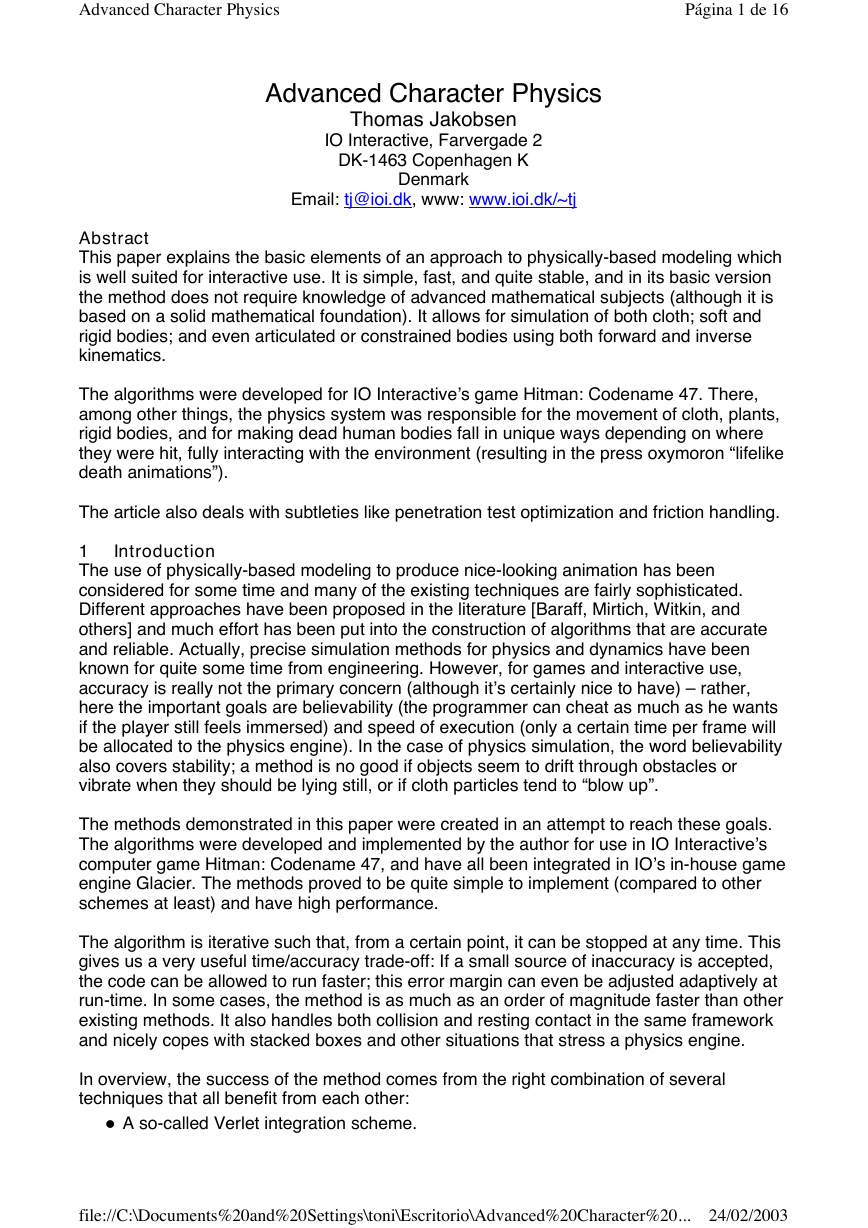
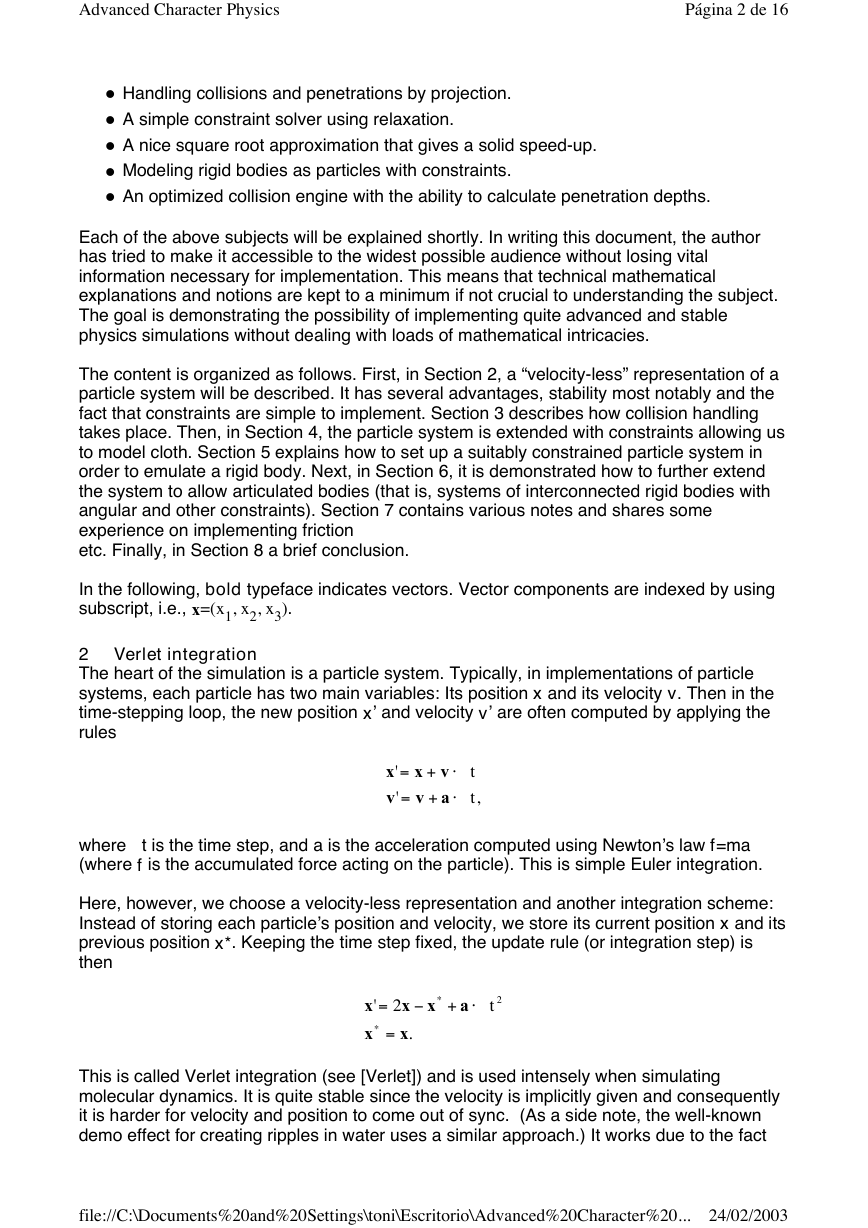
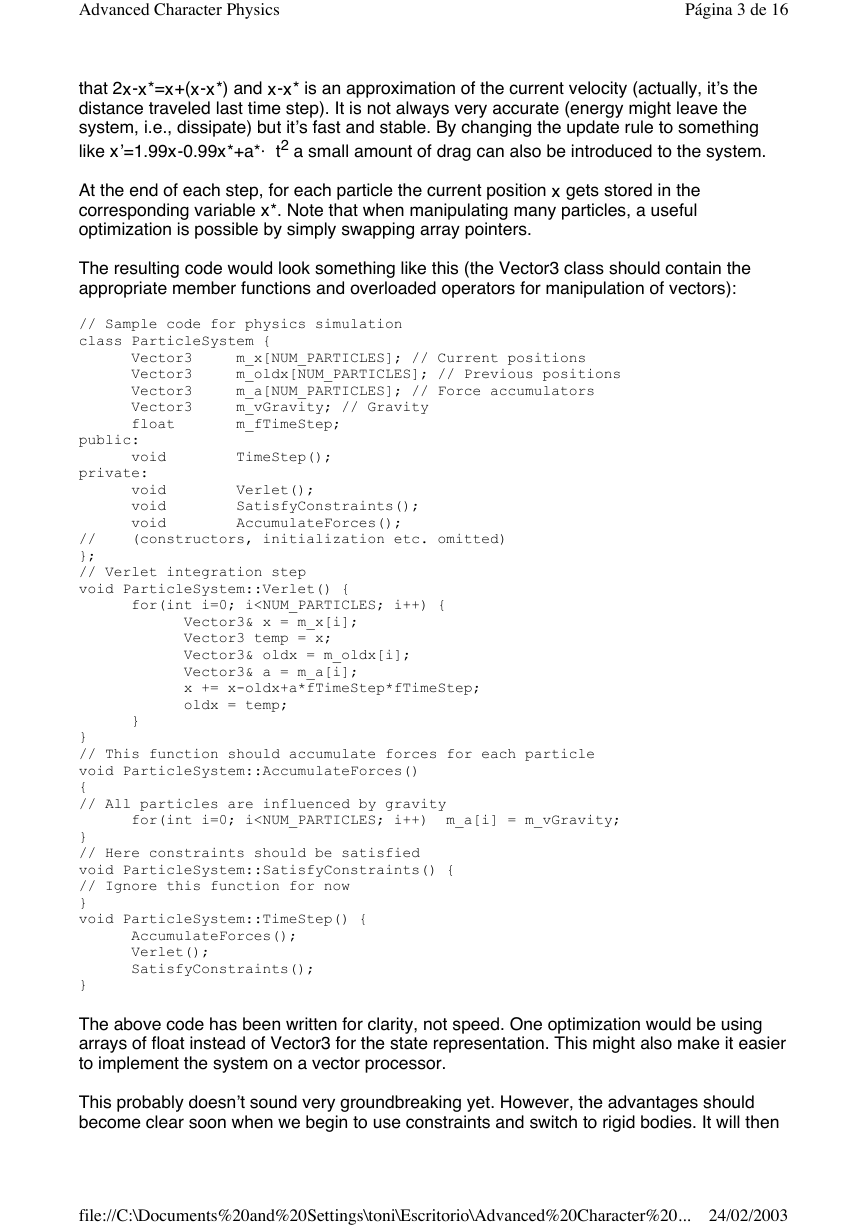
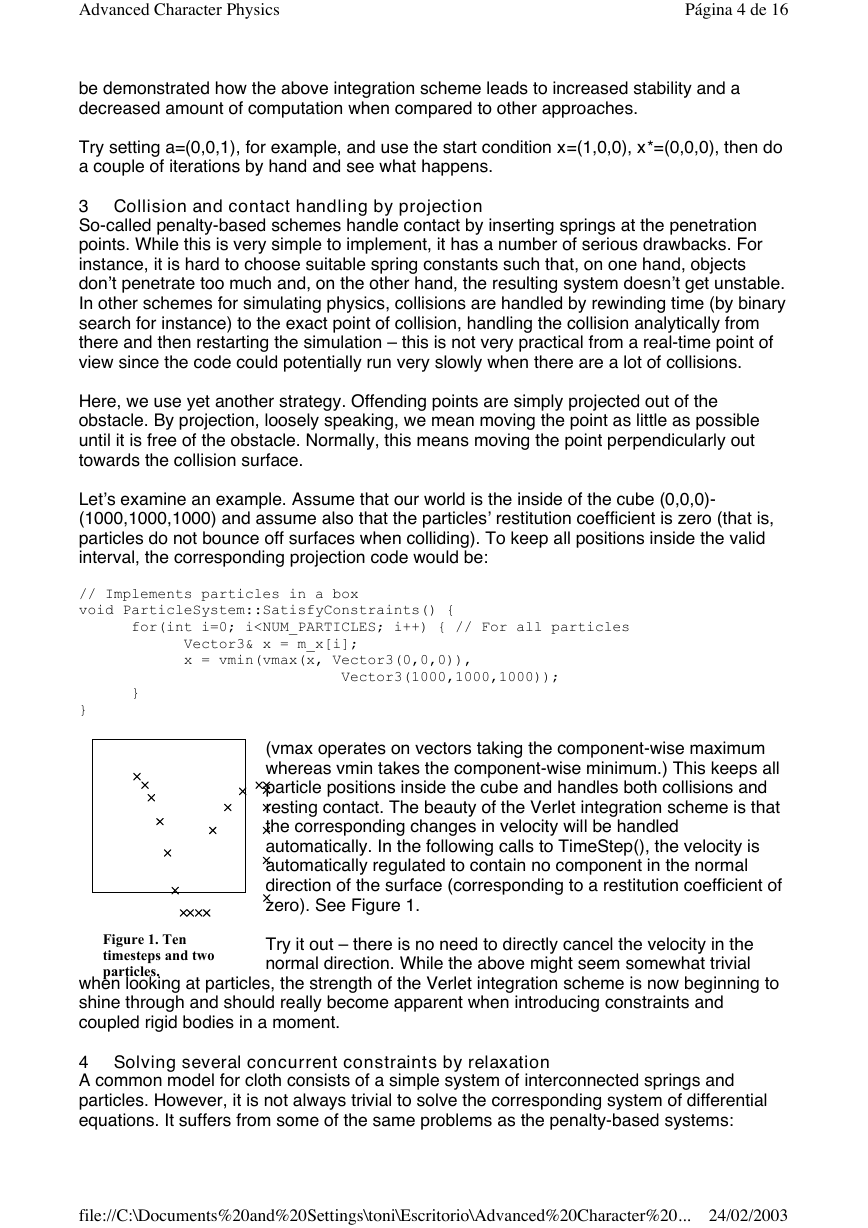
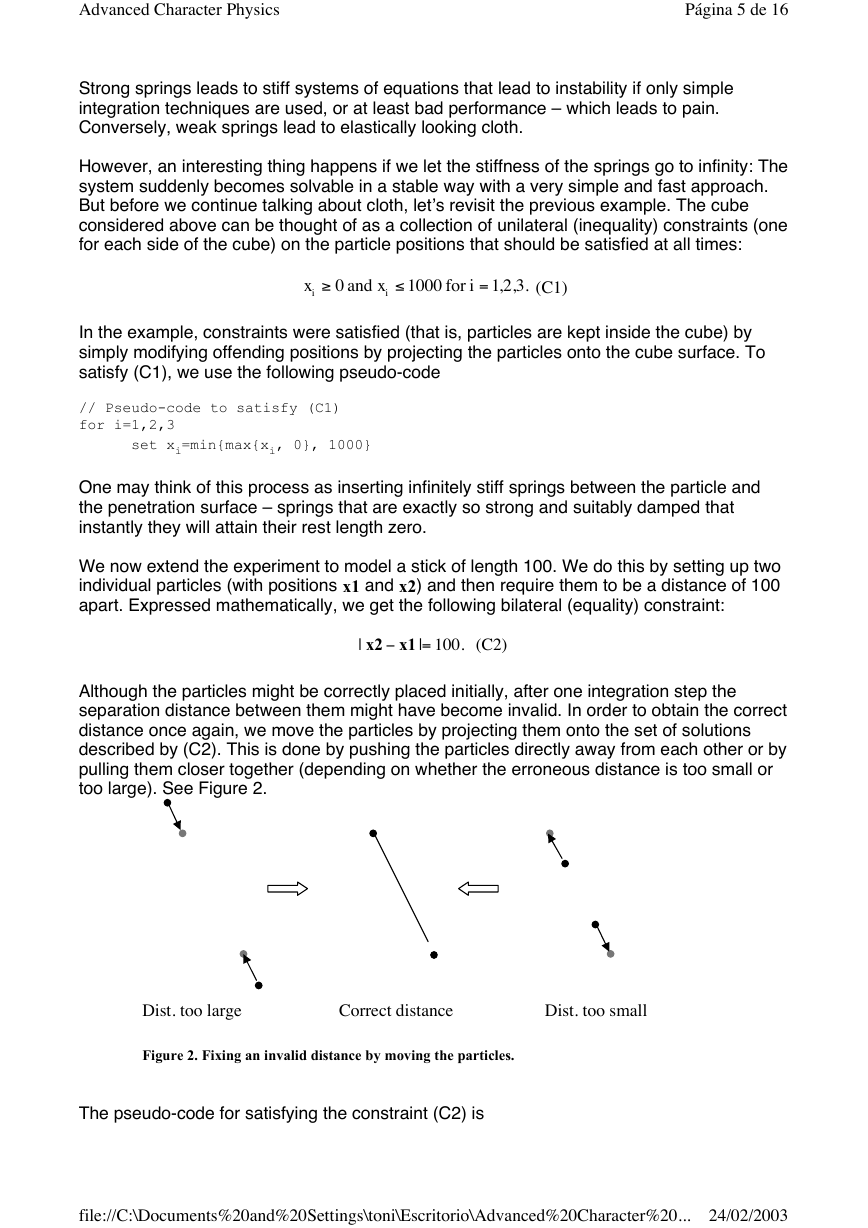
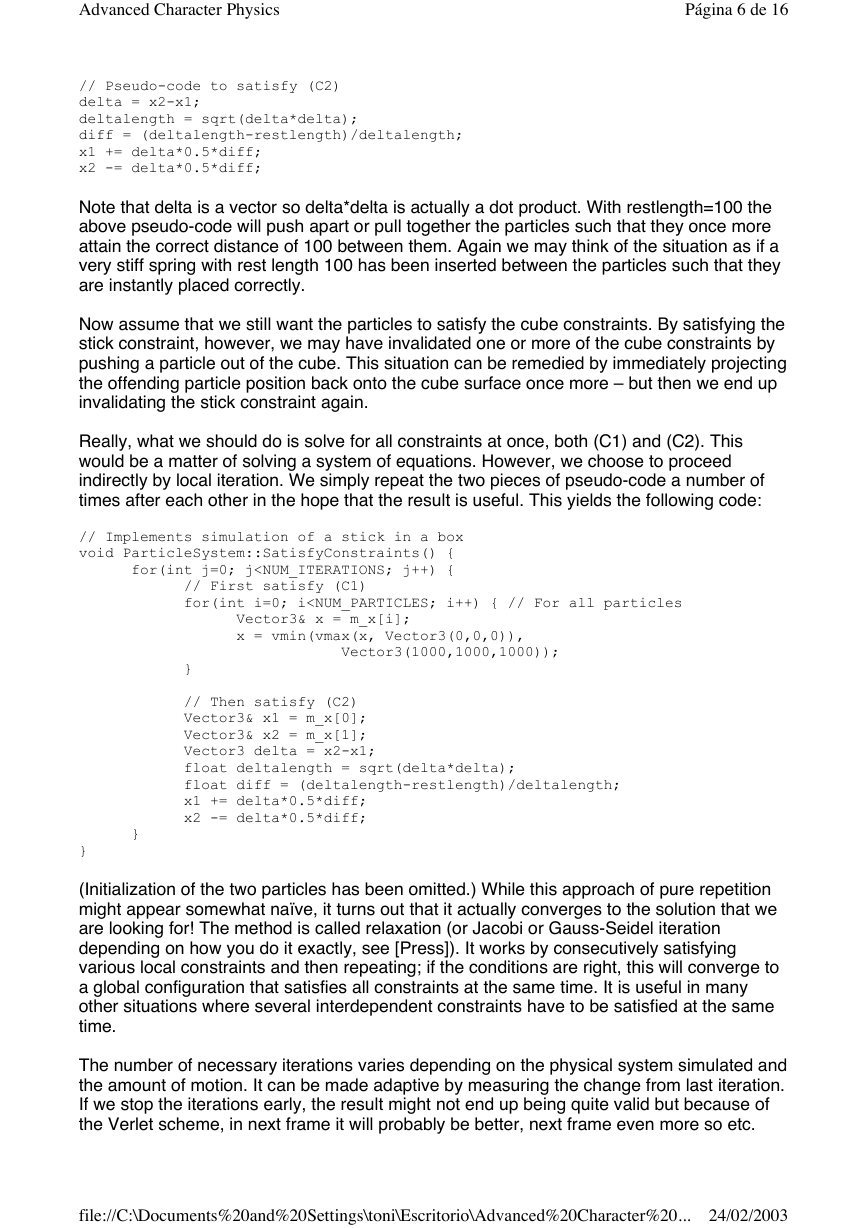
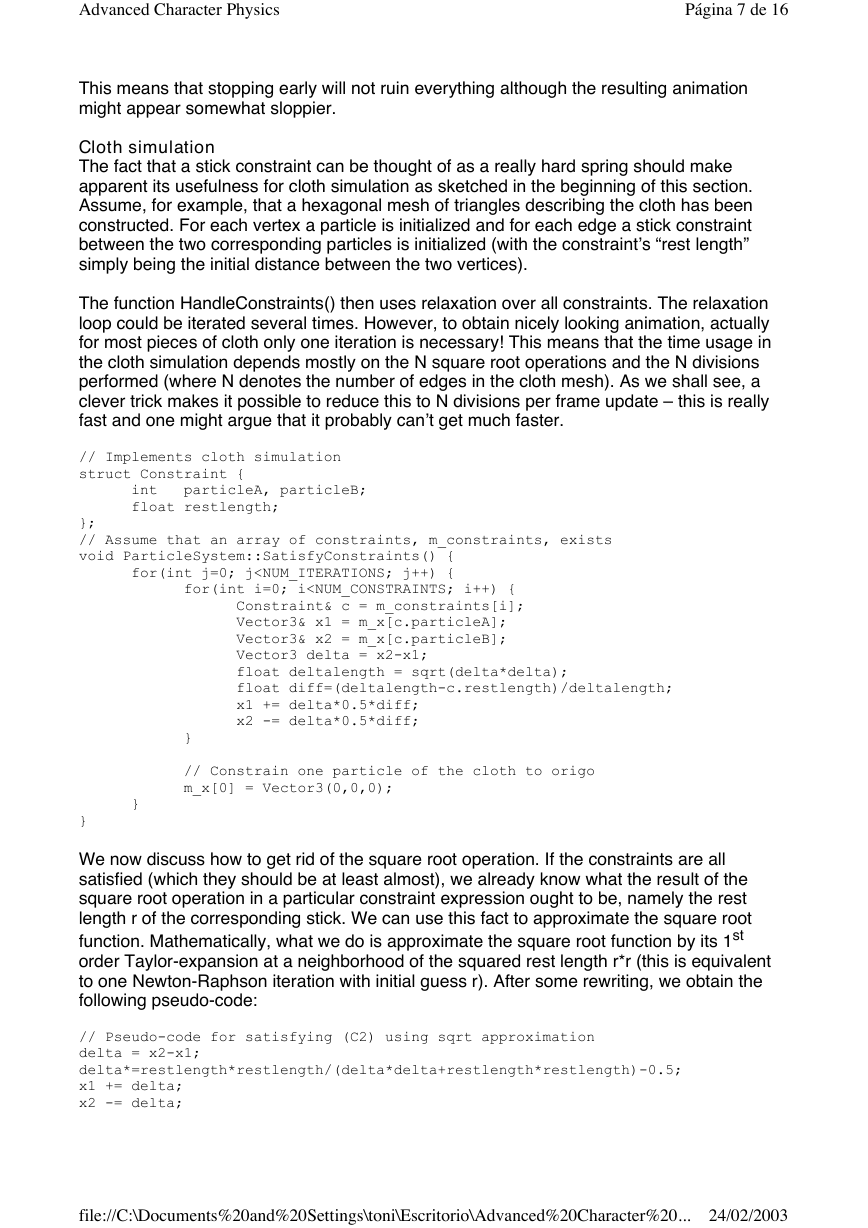
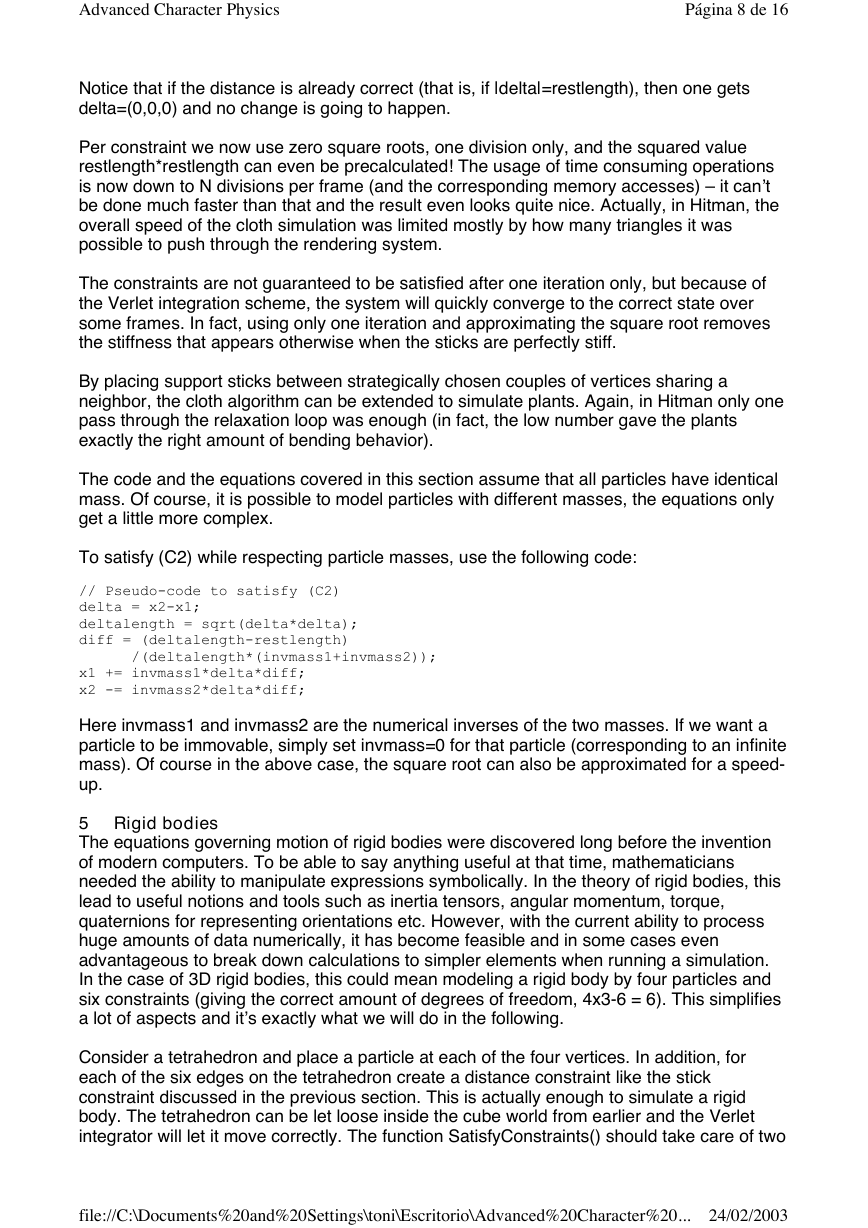








 2023年江西萍乡中考道德与法治真题及答案.doc
2023年江西萍乡中考道德与法治真题及答案.doc 2012年重庆南川中考生物真题及答案.doc
2012年重庆南川中考生物真题及答案.doc 2013年江西师范大学地理学综合及文艺理论基础考研真题.doc
2013年江西师范大学地理学综合及文艺理论基础考研真题.doc 2020年四川甘孜小升初语文真题及答案I卷.doc
2020年四川甘孜小升初语文真题及答案I卷.doc 2020年注册岩土工程师专业基础考试真题及答案.doc
2020年注册岩土工程师专业基础考试真题及答案.doc 2023-2024学年福建省厦门市九年级上学期数学月考试题及答案.doc
2023-2024学年福建省厦门市九年级上学期数学月考试题及答案.doc 2021-2022学年辽宁省沈阳市大东区九年级上学期语文期末试题及答案.doc
2021-2022学年辽宁省沈阳市大东区九年级上学期语文期末试题及答案.doc 2022-2023学年北京东城区初三第一学期物理期末试卷及答案.doc
2022-2023学年北京东城区初三第一学期物理期末试卷及答案.doc 2018上半年江西教师资格初中地理学科知识与教学能力真题及答案.doc
2018上半年江西教师资格初中地理学科知识与教学能力真题及答案.doc 2012年河北国家公务员申论考试真题及答案-省级.doc
2012年河北国家公务员申论考试真题及答案-省级.doc 2020-2021学年江苏省扬州市江都区邵樊片九年级上学期数学第一次质量检测试题及答案.doc
2020-2021学年江苏省扬州市江都区邵樊片九年级上学期数学第一次质量检测试题及答案.doc 2022下半年黑龙江教师资格证中学综合素质真题及答案.doc
2022下半年黑龙江教师资格证中学综合素质真题及答案.doc